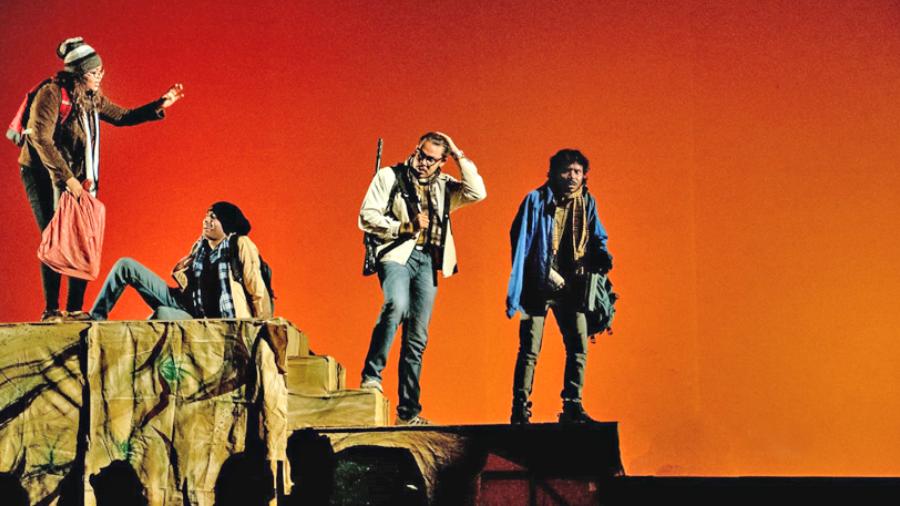Are there still smouldering embers hidden under the ashes of West Bengal’s revolutionary, nationalist past that can spark an inferno of righteous anger at present? Are there ways in which the legacy of Bengal’s armed political activism may be picked up again? These questions form the spine of Prothom Rajnoitik Hatya (picture above), produced by Anya Theatre and written and directed by Debasish Roy.
Undoubtedly in a purple patch in his career as director, Roy proves his talent as a playwright too, coming up with an engaging narrative in which a fictional present collides repeatedly with a historical past. The history of events leading up to the assassination of the turncoat, Narendranath Goswami, in 1908 by revolutionaries finds riveting theatrical representation in which the richly imaginative use of set properties, an insightful light design, and a stylised and energetic performative code interspersed with deeply evocative choreographed singing are combined with aplomb.
Roy is gifted with rare scenographic vision, allowing him to play interesting mind games with his audience. A prime example of this is fabricating the set framework using frayed jute curtains, a network of ropes and light bulbs contained in aluminium bowls. This visually evokes theatrical arenas of the 1970s or the 1980s, thus injecting another temporal layer into the mix, with the audience left free to resurrect memories of the volatile politics of that period. The actors throw in all they have, performing their director’s bidding as parts of a whole so that there is an aesthetic evenness about the performance. Bhaskar, Aphrodite, Abhyuday, Raju, Chiranjib, Sayantan and Arka shine in their roles. The only issue with the play is that the present-day characters and their crises seem pale and shadowy in comparison to their historical counterparts, and the project to sew the present and the past with the thread of revolution remains unconvincing.

A scene from Gorbhodharini
The Bengali fascination with revolutionary politics is, once again, the core concern of Gorbhodharini (picture), produced by Garia Krishti and directed by Sitangshu Khatua. Gorbhodharini was written by Samaresh Majumdar when a generation of left-leaning Bengali youth had begun to find themselves politically rudderless. The Indian National Congress had been relegated to insignificance, the Naxalite movement had petered out and the Communist Party of India (Marxist) was gradually entrenching itself in the rewarding humus of parliamentary democracy instead of pushing leftist agendas. In the novel, four young friends first carry out acts of violence against ‘class enemies’ before escaping to faraway mountains. Hidden in the folds of the hills, they then launch an experiment of organising the indigenous tribal communities into a commune. It needs to be mentioned that Khatua had earlier dramatised Majumdar’s Kalpurush, which, in many ways, is a precursor to Gorbhodharini. The problem is that the theatrical idiom chosen by Khatua in his adaptive strategy remains the same for both novels despite the divergence between the genres of Kalpurush and Gorbhodharini, the former being grounded in political history and the later in political fantasy.
The pull of the play is the performances by the lead actors — Rik, Saptarshi, Gandharbi and Abhigyan — essaying the roles of the four protagonists with unflagging sincerity. The electronic projection system works fabulously in some scenes, demanding more inventive use for the rest of the play. The representation of the tribal people (who jig and not walk, lisp and not speak) smacks of political incorrectness, bordering on the offensive, and requires a thorough redesign.










